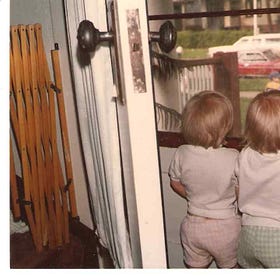Recently, thanks to a podcast conversation with Jessie Harrold, author of Mothershift and host of The Becoming podcast, that released yesterday (listen here!) I discovered the 2017 essay Portrait of a Marriage by Carmen Spagnola. As I’d recently launched The Marriage Diaries (for which I had such an overwhelming response I’m still figuring out the best way to distill all that information), I was looking for more honest, real life accounts of what it takes to stay married, or even more, a peek behind the curtain of what each marriage is truly like.
In Carmen’s bio on her website it says she works at the intersection of attachment, somatics, and personal and collective trauma. And you see this knowledge base in the essay, which I am going to admit was a very, long read. But, I kept reading, recognizing that some of the struggles in my own marriage likely stemmed from our attachment styles.
Disclaimer: I have not done much research or reading on attachment styles but when I read this piece, it resonated so much I realized that attachment style most definitely contributed to my divorce.
A word from Carmen on how attachment styles develop (she goes into a lot of background about attachment in the essay):
“Whether through developmental or shock trauma, people with anxious or avoidant attachment styles have had experiences that made them feel unsafe and insecure within intimate relationships. Sometimes it’s been with parents, but it can also have occurred with siblings, authority figures, friends or romantic relationships. Regardless, those adverse experiences have helped shape their attachment style and adaptive strategies.”
From reading her description of her marriage, I’m going to guess that my ex and I had a similar set up of attachment styles. Husband: anxiously attached. Wife: avoidant attachment.
She notes that “Generally speaking, in western hetero-patriarchal culture, women are conditioned to be anxious attachers and men are conditioned to be avoidant attachers.” But her marriage, and mine, bucked that trend.
Read Carmen’s description below:
“Anxious attachers crave a deep and vulnerable intimacy with their partner, can be preoccupied or even consumed by their relationship, and often worry about whether their partner really loves them. They like a “high contact” relationship that includes regular physical, verbal, written, and/or tangible gestures of connection and reassurance. They spend a lot of time feeling that their relationship could fail at any minute.
Avoidant attachers crave independence and freedom, can be dismissive and withholding in relationships, and (consciously or unconsciously) erect barriers to closeness with their partners. They find “high contact” relationships draining and a threat to their autonomy. Because they don’t equate sex with intimacy, their “mixed signals” can be confusing for anxious attachers.”
Welp. That feels very, very accurate of both me and my ex.
Then, she goes on to say this about avoidant attachers:
“Avoidant attachers don’t relate to needs.
They don’t have a healthy understanding of what needs even are, much less recognize needs as something that everybody has, are normal, natural, and required to fulfill our humanness.
As children, they learned to act as if they were getting what they needed even though they weren’t.
…. Instead, they’ve learned to adopt a mask of okay-ness.
After years of wearing the Mask of Okay, they’ve become quite adept at managing triggering situations without any awareness at all that their brain and body are systematically shutting down.”
Just now I went back to see if I’d talked in another post about how much I struggled to identify my own needs. Honestly, it feels to me like it is the underlying layer beneath all my issues as a wife and mother. Being unable to prioritize my own needs. But the problem was, I couldn’t even name them in order to be able to prioritize them.
Despite me often feeling like I’ve spilled everything in this newsletter, the truth is there is so much I’ve held back or just haven’t had the time to unpack for you. And yes, my inability to identify my needs DID NOT HELP MY MARRIAGE.
Carmen goes on:
“Honestly, I felt revulsion at the notion of having needs, never mind declaring them.
Because here’s the thing: when your default is that your needs will never be met, eventually it’s just a hassle to have them.
If you’re a strong, competent, avoidant female, having needs just adds one more thing to your to-do list of things to manage. You’re probably already having to manage everyone else’s needs so the thought of having your own is supremely irritating and a waste of time.
How about this? you might think. How about everyone just handle their own fucking needs?”
This is 100% how I showed up in my marriage. Yes, I could handle my children’s needs, even though that was so overwhelming and exhausting that I ghosted myself to handle it. But giving birth to two children over the course of two years, three months meant I could no longer handle my husband’s needs. WTF, EVERYONE, CAN’T WE SEE THAT I AM RUNNING ON EMPTY? I’VE GOT NOTHING LEFT TO GIVE!
Sometimes, what my ex asked for in our marriage seemed simple. More words of affirmation, more physical touch. More validation. More gratitude. And yet, I was often incapable of complying with what seemed like straightforward asks.
When you don’t allow yourself to have needs, other people’s needs can feel literally repulsive.
But:
“Fortifying oneself against having normal, healthy, natural human needs cuts us off from our humanity and from the sweetness of interdependence; it closes off the potential for a restful sense of security within relationship.”
Yes. Yes it does.
“It took me a long time to even relate to the concept of having needs, and longer to identify which ones were unmet in my marriage, even longer to feel entitled to my needs, and much longer before I could trust that they might be met by my husband.
It also took a long time before I could accept my husband’s needs without resenting them.
And longer before I could come to terms with the idea that I might perhaps somehow oh I don’t know be responsible for meeting my husband’s needs.”
Reader, I could not handle being responsible for my husband’s needs. Mainly because my own were so neglected. But I couldn’t see that. I just felt his need like an albatross drowning me and the only solution I could find was to cut that fucker off.
But also, of course I felt overwhelmed by his needs. Because patriarchy has designed it so that wives are supposed to be the solution and fulfillment center to whatever needs their husband may have. This is particularly tricky for an anxiously attached man.
“For an anxiously attached man, there is a palpable desire to connect but generally only one locus of fulfillment of that desire: his wife. She becomes his entire world of connection.
Whereas she can go out into the world and regularly exchange hugs, kisses, emotional disclosure and empathy — even sometimes within relatively “light” relationships with female colleagues, or damn even strangers — the most he can hope for is a handshake at work and from friends a hug with an assertive smack on the back while they’re at it.”
Describing perfectly the issues with this particular attachment pairing, Carmen writes this:
“She is avoidant because he’s clawing at her. Makes sense, right?
He is anxious because she’s ghosting him emotionally. Makes sense.
They are each perceiving reality correctly, but their responses are born of trauma, and therefore make everything worse and even harder than it could be.”
Those five sentences feel like the summary of my marriage and why we ultimately got divorced. Of course, there were many reasons. Fair Play. When I quit working and became a stay-at-home mom due to the pandemic. There are so many reasons we didn’t work. But our attachment styles were at the heart of it. Why we couldn’t turn to each other when things were stressful. Why we each felt so alone in our marriage. Why we couldn’t escape this cycle.
Our couples’ therapists did not work with attachment style. I wish one of them did. (We had three over the course of our 19 year relationship). Carmen states that our attachment styles aren’t fixed, and she provides concrete, actionable advice on how to work with these attachment styles in the essay (namely, learning to identify when you are triggered and shutting down, learning to self-regulate and then return to the discussion). Of course my marriage is over so I won’t be using these tips for that relationship. I hope to learn to identify secure attachment in future relationships so I don’t get yet again onto this merry-go-round. My work in therapy for the past few years has been to identify my needs, and believe that they matter.
Now, as I dip my toe into the dating world, all my work will be put to the test. Can I learn to show up for myself in relationships without ghosting myself? Will I learn to tolerate another person’s needs? Honestly, that question still makes me want to vomit. Which signals perhaps I need more growth and healing before I can offer myself in a relationship.
But one of my goals for my next decade is to learn to depend on others. To set boundaries and also open myself up. To experience interdependence rather than codependence. It feels impossible. And yet I know that learning this will set me on the path to a more balanced, connected, loving future.
What about you? Have you determined your attachment style? Any books, therapists I must seek out? Did anything about the above dynamic feel familiar to you?
Liking this post, restacking it, or leaving a comment helps it find more readers. And if you consistently find value in the writings on The Mother Lode, please consider becoming a paid subscriber. Your financial contribution helps me do this work and signals its value. It also grants you access to all content on The Mother Lode.
Read Carmen’s full essay here.
ICYMI:
On Care and Codependency
I wrote a few weeks about about the benefits of becoming unhinged via the spectacular Miranda July novel, All Fours. It certainly seems to be the novel of the moment for a certain subset of women. Th…
Death by a Thousand Negotiations
The Mother Lode is a reader-supported publication. To receive new posts and support my work, consider becoming a free or paid subscriber.Don’t take it on they say as if I should know how to keep expe…






Here's another take from a feminist psychotherapist: You did the vast majority of childcare and unpaid household labor in your family and were responsible for the vast majority of the mental load and general emotional caretaking. You were exhausted and overwhelmed. I don't for one minute believe that you didn't "communicate" this to your husband--it was not a secret and if he was paying the slightest bit of attention to you, and if he valued the work you were doing as actual labor, he would have easily perceived your overwhelm. If he actually cared about you, he then would have offered to do his fair share, because relieving your suffering would have been his top priority. But he didn't, because he didn't pay attention, didn't perceive what you were doing as labor, and/or didn't want to give up his place of privilege and increase his own workload. He just wanted to add servicing his needs to your endless list of caretaking duties. This is why I never, ever recommend my clients (all women) seek relationship counseling. Almost all marriage counselors hide behind the language of "attachment styles" and place the onus completely on the female partner to "communicate better." This is bullshit. Men aren't stupid, they just don't want to do more work.
An amazing book when it comes to attachment styles in parenting is Strange Situation: A Mother's Journey Into the Science of Attachment.